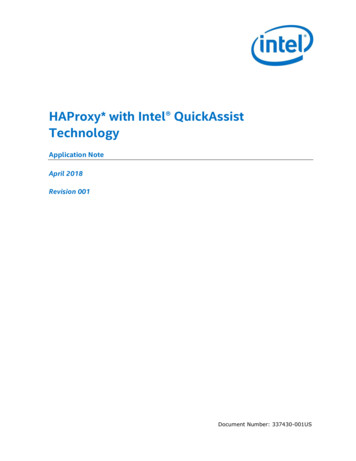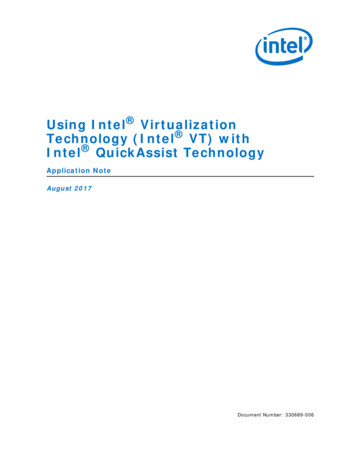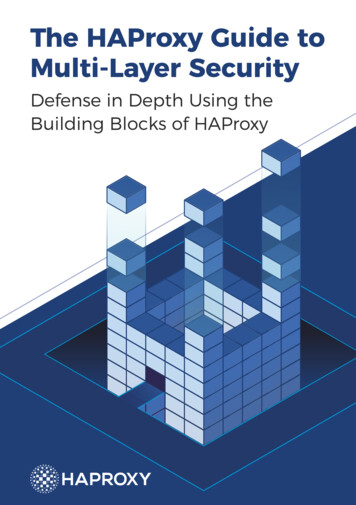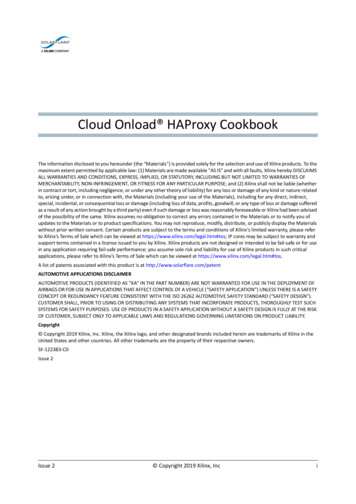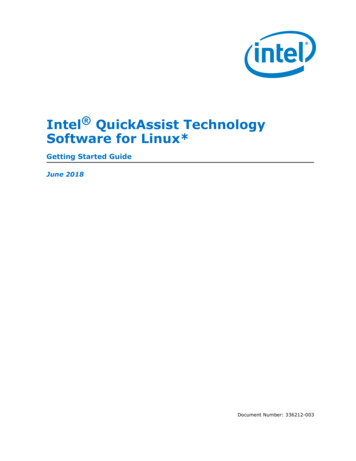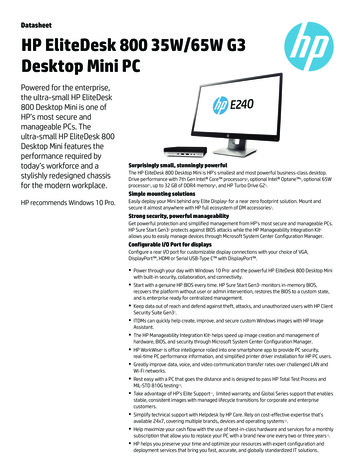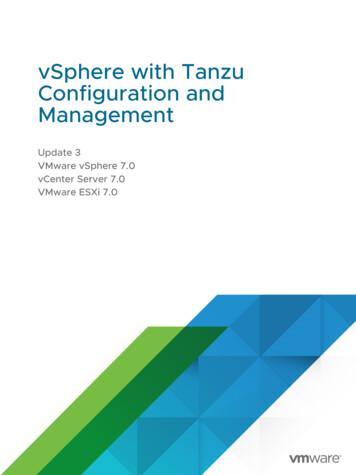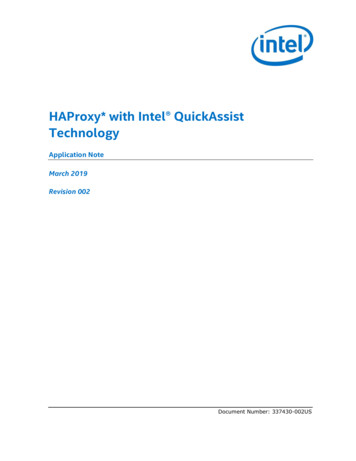
Transcription
HAProxy* with Intel QuickAssistTechnologyApplication NoteMarch 2019Revision 002Document Number: 337430-002US
You may not use or facilitate the use of this document in connection with any infringement or other legal analysis concerning Intel productsdescribed herein. You agree to grant Intel a non-exclusive, royalty-free license to any patent claim thereafter drafted which includes subjectmatter disclosed herein.No license (express or implied, by estoppel or otherwise) to any intellectual property rights is granted by this document.Intel technologies' features and benefits depend on system configuration and may require enabled hardware, software or service activation.Performance varies depending on system configuration. No computer system can be absolutely secure. Check with your system manufacturer orretailer or learn more at intel.com.Intel technologies may require enabled hardware, specific software, or services activation. Check with your system manufacturer or retailer.The products described may contain design defects or errors known as errata which may cause the product to deviate from publishedspecifications. Current characterized errata are available on request.Intel disclaims all express and implied warranties, including without limitation, the implied warranties of merchantability, fitness for a particularpurpose, and non-infringement, as well as any warranty arising from course of performance, course of dealing, or usage in trade.All information provided here is subject to change without notice. Contact your Intel representative to obtain the latest Intel productspecifications and roadmaps.Copies of documents which have an order number and are referenced in this document may be obtained by calling 1-800-548- 4725 or visitwww.intel.com/design/literature.htm. No computer system can be absolutely secure.Intel, Intel QuickAssist, and the Intel logo are trademarks of Intel Corporation in the U.S. and/or other countries.*Other names and brands may be claimed as the property of others.Copyright 2019, Intel Corporation. All rights reserved.HAProxy* with Intel QuickAssist TechnologyApplication Note2March 2019Document Number: 337430-002US
Contents1.0Introduction .51.11.21.31.42.0Operating System and Virtual Machine Setup .72.12.22.33.0Generate a Self-Signed Certificate . 12Update the HAProxy Configuration File . 12Starting HAProxy . 12Testing HAProxy . 12Intel QuickAssist Technology Setup and Testing . 145.15.25.36.0Installing HAProxy .9Verifying HAProxy Installation . 10Testing HAProxy Configurations . 10HAProxy* Setup and Testing for HTTPS Connections . 124.14.24.34.45.0Install the Host Operating System .7Install and Configure the Virtual Machines .7Test the Virtual Machines .7HAProxy* Setup and Testing for HTTP Connections .93.13.23.34.0Network Topology.5Resources and Prerequisites.5Terminology.5Reference Documents .6OpenSSL and QAT Engine Setup and Testing . 14HAProxy* Intel QAT Setup . 14HAProxy* Intel QAT Testing . 14HAProxy* QAT Performance Testing . 166.1Performance Tips . 17TablesTable 1.Table 2.Terminology .5Reference Documents .6March 2019Document Number: 337430-002USHAProxy* with Intel QuickAssist TechnologyApplication Note3
Revision sion Date337430002Updated with performance considerationsMarch 2019337430001Initial release.April 2018§HAProxy* with Intel QuickAssist TechnologyApplication Note4March 2019Document Number: 337430-002US
Introduction1.0IntroductionThis document details the steps necessary to configure HAProxy* to work with Intel QuickAssist(Intel QAT) Technology.1.1Network TopologyWhile other configurations are possible, this document focuses on a simple “Secure SocketsLayer (SSL) Termination” topology in which a frontend proxy server with Intel QuickAssistTechnology handles traffic between clients and backend servers.In this case, the connections between the proxy server and clients use secure protocols, butconnections between the proxy and backend servers do not use secure protocols. Thisconfiguration essentially offloads the security workload to the proxy server so the backendservers don’t have to carry the overhead of the secure protocols.In practice, this topology uses multiple systems: for easier configuration, this application note hasbeen written such that the setup may be tested with just one system. The backend servers will beVirtual Machines (VMs) on the one system, and the client traffic can also be generated on thesame system.1.2Resources and PrerequisitesBefore working through this document, the following fundamentals are required: General familiarity with Intel QAT.Technical collateral, including links to tutorial videos, are available at https://01.org/intelquickassist-technology. Familiarity with the OpenSSL* QAT engine:Details are available via the “Intel QuickAssist Technology - libcrypto/openssl resources”,Table 2, which includes the link to the Intel QAT Engine GitHub page:https://github.com/intel/QAT Engine/. 1.3Table 1.A system with Intel QAT el QATIntel QuickAssist TechnologySSLSecure Sockets LayerMarch 2019Document Number: 337430-002USHAProxy* with Intel QuickAssist TechnologyApplication Note5
IntroductionTermVMs1.4Table 2.DescriptionVirtual MachinesReference DocumentsReference DocumentsDocumentDocumentNo./LocationIntel QuickAssist Technology - libcrypto/openssl yIntel QuickAssist Technology Software for Linux* - Getting Started logyIntel QuickAssist Technology Performance Sample quickassisttechnology-performancesample-codeIntel QuickAssist Technology: Performance Sample Code gIntel QuickAssist Technology (Intel QAT): OPENSSL 1.1.x Intel §HAProxy* with Intel QuickAssist TechnologyApplication Note6March 2019Document Number: 337430-002US
Operating System and Virtual Machine Setup2.0Operating System and Virtual Machine SetupThis section provides instructions on how to install the Linux* operating system (OS) on the hostsystem. Instructions are provided for the setup of two virtual machines (VMs), which are used asbackend web servers for testing purposes.2.1Install the Host Operating SystemFrom https://01.org/intel-quickassist-technology, find the applicable “Intel QuickAssistTechnology Software for Linux* - Getting Started Guide.” Follow the “Installing the OperatingSystem” chapter to install Linux* on your system. It isn’t a requirement to follow the steps exactly,but following the steps should ensure that you do not encounter build errors or other errors.2.2Install and Configure the Virtual MachinesFor functional testing, there are no specific requirements for the VMs and, in fact, they do nothave to be VMs at all. These will be acting as backend web servers; for testing purposes we’ll setup two of these. For ease of setup and configuration, the VM Manager GUI can be used to installthe latest Ubuntu* Server distribution on each of these virtual machines. Name the virtualmachines intuitively: for instance, "MyWebServer1" and "MyWebServer2". Select the option toenable ssh access to make remote configuration and debug easier.Once the operating systems for the backend web servers have been installed and configured, youmay optionally shut down the VMs and then use virsh and ssh to access these, for easier remoteaccess.2.3Test the Virtual MachinesWith the virtual machines shut down and the Virtual Machine Manager GUI closed, run “sudovirsh list --all” to see the available virtual machines: for instance, "MyWebServer1" and"MyWebServer2" should show these are “off”.From this point forward, assume the names of the virtual machines are "MyWebServer1" and"MyWebServer2".1.Start MyWebServer1 using “sudo virsh start MyWebServer1”.2.Obtain the IP address associated with MyWebServer1 using “sudo virsh domifaddrMyWebServer1”.3.Connect to MyWebServer1 using “ssh 192.168.122.xxx”.Insert the correct IP address obtained in Step two.March 2019Document Number: 337430-002USHAProxy* with Intel QuickAssist TechnologyApplication Note7
Operating System and Virtual Machine Setup4.If necessary, update the apt-get proxy for the host environment.This may be enabled by adding the following to a new file located at /etc/apt/apt.confusing the following script, substituting your specific details for the placeholders:Acquire::http::Proxy "http:// yourproxyIP : yourproxyport ";5.After a “sudo apt-get update” (or equivalent), use “sudo apt-get install nginx”to install nginx*.6.From the host operating system, enter “wget IPWebServer1 ”.This should download an index.html file to the current working directory. If so,MyWebServer1 VM web server has been configured correctly.Successive requests of wget will not overwrite the index.html by default; instead, it will savethe file with a slightly different filename.Look at the nginx config file located in /etc/nginx/nginx.conf to determine where themain html page is located. It may be located at /var/www/html/index.nginxdebian.html. Copy or move the config file as necessary and/or edit/etc/nginx/nginx.conf to point to your main html page.Make the index.html (or other main html page file) unique to distinguish it from the otherbackend web server. For instance, change the text in the title tag to “MyWebServer1” andthe text in the body section to display a unique string. For instance, you can have thisparagraph in index.html: p MyWebServer1 /p 7.Repeat Steps 1 through 6 of this section to setup MyWebServer2, substituting“MyWebServer1” with “MyWebServer2” and using the MyWebServer2 IP address.§HAProxy* with Intel QuickAssist TechnologyApplication Note8March 2019Document Number: 337430-002US
HAProxy* Setup and Testing for HTTP Connections3.0HAProxy* Setup and Testing for HTTPConnectionsHAProxy added support for asynchronous crypto engines beginning with v1.8.0.Generally speaking, for best results, start with the latest stable HAProxy package located here:http://www.haproxy.org/.For more information, refer to release announcement located .org/msg28004.html.As noted in the announcement, support for asynchronous engines requires OpenSSL 1.1.x orlater.In many, if not most cases building HAProxy from the source may be required for the foreseeablefuture if support for asynchronous engines is required. If you are installing HAProxy from apackage manager (such as dnf, yum, or apt-get), check for the OpenSSL v1.1.x dependency,using the following command:# haproxy -vvThis command will show information about the HAProxy version (e.g. v1.8 or greater) and alsothe OpenSSL version (e.g. v1.1.0 or greater). Running “ldd haproxy” also gives insight into theHAProxy assumptions and environment.It’s strongly recommend to remove old HAProxy versions when installing a newer version.From here, assume HAProxy will be built from the source.3.1Installing HAProxy1.Download the latest stable branch from http://www.haproxy.org/.2.Untar the source file and enter the HAProxy root directory.3.Use the following commands to ensure that OpenSSL v1.1.0 or later is being used for theHAProxy build, set SSL INC and SSL LIB to OpenSSL 1.1.0 and include librarydirectories, respectively. For instance:# export SSL INC /usr/local/ssl/include# export SSL LIB /usr/local/ssl/libIf a “make install” of the OpenSSL v1.1.0 was not done or if it was installed in differentdirectories, adjust the environment variables above to point to the correct directories.4.Use the following command to build HAProxy:# make TARGET linux2628 USE OPENSSL 1Assuming that this compiles correctly, verify immediately that “./haproxy -vv” shows ithas been built and is running against the 1.1.0 . You can also run “ldd haproxy”. Verifythat it does not show libssl.so.10.With a typical OpenSSL 1.1.0 installation, the following message may appear when trying toMarch 2019Document Number: 337430-002USHAProxy* with Intel QuickAssist TechnologyApplication Note9
HAProxy* Setup and Testing for HTTP Connectionsrun HAProxy:# ./haproxy -vv./haproxy: error while loading shared libraries: libssl.so.1.1:cannot open shared object file: No such file or directoryRun the following command to avoid this error:# export LD LIBRARY PATH /usr/local/ssl/lib3.2Verifying HAProxy Installation1.2.The output of “haproxy -vv” should be similar to the following:# ./haproxy -vv.OPTIONS USE OPENSSL 1.Built with OpenSSL version : OpenSSL 1.1.0g2 Nov 2017Running on OpenSSL version : OpenSSL 1.1.0g.2 Nov 2017The output of “ldd haproxy” should be similar to the following:# ldd ./haproxylinux-vdso.so.1 (0x00007fff72bb6000)libcrypt.so.1 /lib64/libcrypt.so.1 (0x00007f26c49b5000)libdl.so.2 /lib64/libdl.so.2 (0x00007f26c47b0000)libpthread.so.0 o.1.1 0)libcrypto.so.1.1 f000)libc.so.6 /lib64/libc.so.6 (0x00007f26c3adc000)libfreebl3.so /lib64/libfreebl3.so (0x00007f26c38d9000)/lib64/ld-linux-x86-64.so.2 (0x0000558b75ebd000)Optionally, do a “make install” of HAProxy.Because of the differences in distributions, the instructions to start HAProxy on boot are outsidethe scope of this document.There are many HAProxy configuration options. Consult the examples directory located in theHAProxy directory to understand which options are available.3.3Testing HAProxy Configurations1.To test a simple HAProxy configuration, use the following HAProxy configuration file:frontend myfrontendbind *:80default backend mybackendHAProxy* with Intel QuickAssist TechnologyApplication Note10March 2019Document Number: 337430-002US
HAProxy* Setup and Testing for HTTP Connectionsbackend mybackendbalance roundrobinmode httpserver myvm1 ipaddress1 :80 check # e.g. 192.168.1.101:80server myvm2 ipaddress2 :80 check # e.g. 192.168.1.101:80Change the ipaddress# placeholders so they point to your MyWebServer1 andMyWebServer2 VM IP addresses.2.Save the configuration file to any accessible directory. For testing purposes, invoke HAProxywith an explicit path to the configuration file. Optionally, you may need to save this as/etc/haproxy/haproxy.cfg. For our purposes we assume the HAProxy configuration filewill reside at /etc/haproxy/haproxy.cfg.3.Invoke HAProxy as follows:# haproxy -f /etc/haproxy/haproxy.cfgIf any errors or warnings are reported, be sure to understand these and deal with them asnecessary.4.Test that HAProxy is working correctly on the host operating system by using the followingcommand:# wget 127.0.0.1Alternatively, run wget or access the service IP address from a client system using wget or aWeb Browser. If set up correctly, the index.html* file will include the default web page ofthe virtual machine, along with any modifications that were made (e.g. changing the title tag to “MyWebServer1”). Each successive invocation should show the index.html file ofthe next web server virtual machine, since we told HAProxy to use the roundrobin algorithm.§March 2019Document Number: 337430-002USHAProxy* with Intel QuickAssist TechnologyApplication Note11
HAProxy* Setup and Testing for HTTPS Connections4.0HAProxy* Setup and Testing for HTTPSConnectionsTo test HAProxy with HTTPS connections, create or obtain a certificate, update the HAProxyconfiguration file to redirect the HTTPS requests (via port 443) to the backend servers (on port80).4.1Generate a Self-Signed CertificateFollow the steps below to create a self-signed certificate for HTTPS testing, as root:# mkdir /etc/ssl/myhaproxy# cd /etc/ssl/myhaproxy# ./openssl req -x509 -sha256 -nodes -days 365 -newkey rsa:2048 -keyout\myhaproxy.key -out myhaproxy.crt# sudo cat y/myhaproxy.key \/etc/ssl/myhaproxy/myhaproxy.pem4.2Update the HAProxy Configuration FileJust one additional line is required in the haproxy.cfg, to redirect the port 443 traffic to port80 on the backend servers:frontend myfrontendbind *:80bind *:443 ssl crt /etc/ssl/myhaproxy/myhaproxy.pemdefault backend mybackendbackend mybackendbalance roundrobinmode httpserver myvm1 ipaddress1 :80 check # e.g. 192.168.1.101:80server myvm2 ipaddress2 :80 check # e.g. 192.168.1.102:804.3Starting HAProxyinvoke HAProxy as follows:# haproxy -f /etc/haproxy/haproxy.cfgIf any errors or warnings are reported, be sure to understand these and deal with them asnecessary.4.4Testing HAProxyTo test that HAProxy is working correctly, run the following command on the host operatingsystem:# wget --no-check-certificate https://127.0.0.1HAProxy* with Intel QuickAssist TechnologyApplication Note12March 2019Document Number: 337430-002US
HAProxy* Setup and Testing for HTTPS ConnectionsAlternatively, run wget or access the service IP address from a client system using wget or a webbrowser with “https://” explicitly specified before the IP address. When set up correctly, youshould see the index.html* file has been downloaded successfully.§March 2019Document Number: 337430-002USHAProxy* with Intel QuickAssist TechnologyApplication Note13
Intel QuickAssist Technology Setup and Testing5.0Intel QuickAssist Technology Setup andTestingObtain a copy of the Intel QuickAssist Technology Software for Linux* - Getting Started Guide(see Table 2). Follow these instructions to install and test the Intel QAT package. Ensure thatsome Intel QAT sample code can be run successfully before continuing.5.1OpenSSL and QAT Engine Setup and TestingRefer to OpenSSL and Intel QAT Engine materials for setup and testing. Refer to Table 2, “Intel QuickAssist Technology - libcrypto/openssl resources” which includes the link to the Intel QATengine GitHub page: https://github.com/intel/QAT Engine/.Versions of OpenSSL earlier than v1.1.0 do not support Intel QAT engine.5.2HAProxy* Intel QAT Setup1.Enable Intel QAT in HAProxy by adding the following to the bottom of the global section inthe haproxy.cfg file:ssl-engine qat algo RSAAs desired, experiment with other variants of the ssl-engine line.2.For asynchronous operations, which should generally give better performance, include thisat the bottom of the global section in the haproxy.cfg file:ssl-mode-asyncConsult the HAProxy documentation for additional information on these parameters.You may want to consider other HAProxy options, including “tune.ssl.default-dhparam 2048”.3.Now invoke HAProxy as follows:# haproxy -f /etc/haproxy/haproxy.cfgIf any errors or warnings are reported, be sure to understand these and deal with them asnecessary.5.3HAProxy* Intel QAT TestingNow test that HAProxy is working correctly using the following command:# wget --no-check-certificate https://127.0.0.1HAProxy* with Intel QuickAssist TechnologyApplication Note14March 2019Document Number: 337430-002US
Intel QuickAssist Technology Setup and TestingAlternatively, run wget or access the service IP address from a client system using wget or a webbrowser with “https://” explicitly specified before the IP address. When set up correctly, youshould see that the index.html* file is downloaded successfully.To verify Intel QAT is being used successfully, note that the latest Intel QAT driver has a/sys/kernel/debug/qat */fw counters file which can be “cat”ed out to show the firmwarerequests. If this number increases when the web request is made, then Intel QAT is being used. Ifthis number does not increase, Intel QAT is not being used.If this test is not successful, double-check the steps of each previous section, paying carefulattention to the fact that the minimum required version of HAProxy is v1.8, and it must beexplicitly built with OpenSSL v1.1.0 or greater.§March 2019Document Number: 337430-002USHAProxy* with Intel QuickAssist TechnologyApplication Note15
HAProxy* QAT Performance Testing6.0HAProxy* QAT Performance TestingBefore concluding that Intel QAT is a bottleneck in any configuration, first rule out other possiblebottlenecks. These could be related to the following, on the clients, the frontend servers, or thebackend servers: System memory CPU utilization Network bandwidth PCIe* bandwidth Other system settings or limitations.As a general rule, to be sure that the right performance conclusions are made, ensure that youcan get the performance expected in each of the following configurations: HAProxy without HTTPS HAProxy with HTTPS, but without Intel QAT being used HAProxy with HTTPS and with Intel QAT being used.For instance, if measuring connections per second, use benchmarking software such as ab tomeasure the connections per second. After confirming that the numbers are reasonable withHTTP connections, measure the numbers with and without Intel QAT, keeping in mind that if thesoftware employed uses keep-alive connections, then the connections per second will notinclude unique handshakes for each connection.To confirm that all new connections are unique connections and are not a continued session(keepalive), when using Intel QAT, run a continued check of/sys/kernel/debug/qat */fw counters to make sure that this assumption is correct.If these tests lead you to believe that Intel QAT is the bottleneck, first check for the performanceof Intel QAT using the performance sample code and also via OpenSSL speed, as discussed inthese videos: Intel QuickAssist Technology Performance Sample Code: assist-technology-performance-sample-code Intel QuickAssist Technology: Performance Sample Code bug Intel QuickAssist Technology (Intel QAT): OPENSSL 1.1.x Intel QAT o use more than one Intel QAT endpoint, it may be necessary to change the value ofLimitDevAccess in the Intel QAT configuration files (and then restart the qat service, orqat service vfs, if employing a virtualized use case).HAProxy* with Intel QuickAssist TechnologyApplication Note16March 2019Document Number: 337430-002US
HAProxy* QAT Performance Testing6.1Performance TipsGetting so-called “full” performance involves complex tradeoffs that may include memory, CPUutilization, logging, security, availability, and more. Keep in mind that some settings areundesirable in production even if they yield higher performance metrics.Understand which performance metrics are important for a given use case. For instance, thesecan be (among other things) unique connections per second, bulk crypto throughput, andlatency.Start with HAProxy using nbthreads of 1, plus taskset HAProxy to one core (and itscorresponding logical core), then scale nbthreads plus the cores (and corresponding logicalcores) up until performance levels out. Do this for the HTTP case and for the HTTPS QAT case. Inthis way, you may find that system settings or other settings are limiting performance.Disable unnecessary logging.Use htop on all applicable systems to monitor CPU utilization as the performance increases. IfCPU utilization is maxing out, consider adding more cores to the taskset command. If CPUutilization and memory are not maxing out (on the clients, frontend server, or backend servers)but the performance is leveling off unexpectedly, consider other possibilities: Adjust web server setttings. Adjust HAProxy settings. Add more backend servers, or adjust other settings associated with the backend servers (e.g.increasing worker processes). Ensure that the available ports are not being exhausted; reuse ports if necessary; run“netstat grep TIME WAIT” to check for used sockets, and adjustnet.ipv4.tcp max tw buckets or other relevant parameters as necessary. When applicable, use parallel instances of the software that stresses the setup. Increase the maximum open files limit in the environment (e.g. via ulimit). Experiment with different client benchmarking software, since some software will be moreeffective at stressing the setup. Increase maxconn in the HAProxy config file. Considering doing more performance tuning on a Linux* distribution that is preconfiguredfor high performance.§March 2019Document Number: 337430-002USHAProxy* with Intel QuickAssist TechnologyApplication Note17
HAProxy* with Intel QuickAssist Technology March 2019 Application Note Document Number: 337430-002US 9 3.0 HAProxy* Setup and Testing for HTTP Connections HAProxy added support for asynchronous crypto engines beginning with v1.8.0. Generally speaking, for best results, start with the latest stable HAProxy package located here:
